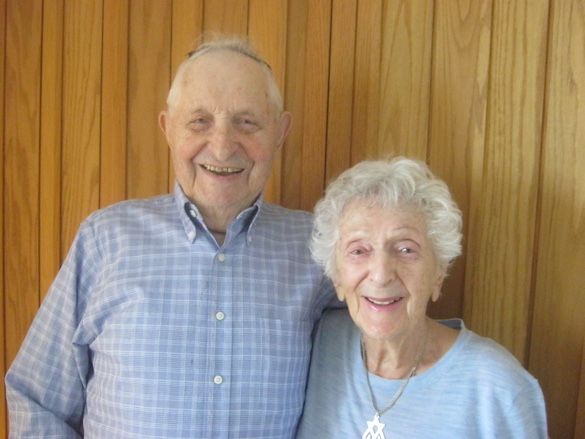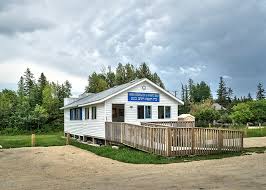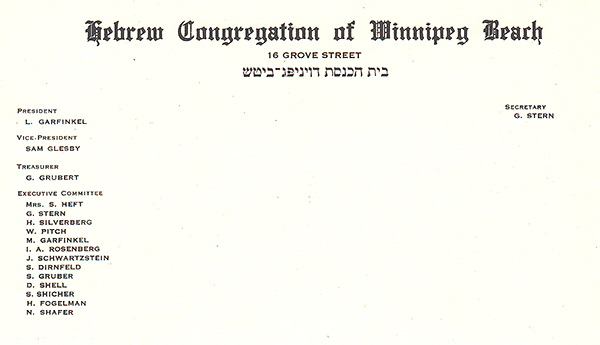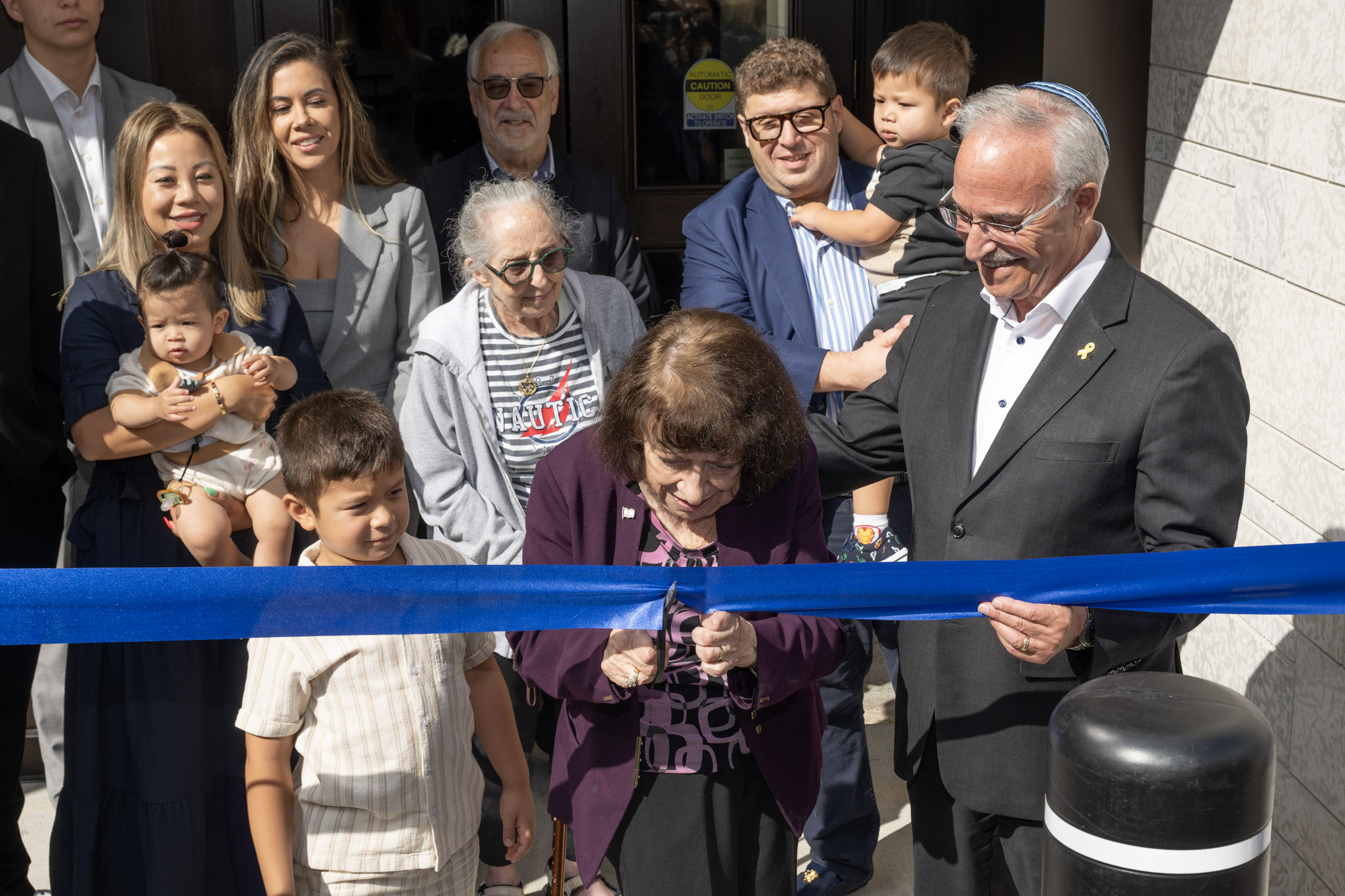Local News
Beloved Chazan Sol Fink celebrates 100th birthday

By MYRON LOVE On December 24, Sol Fink, who both as shoichet and chazan served our community for many years, celebrated his 100thbirthday. In keeping with his low key approach to life, Fink commemorated the occasion only with those closest to him – his wife, Rachel, his children, grandchildren, and great-grandchildren, as well as his last remaining sibling, Ruth Zimmer.
Sol Fink is a man who is infused with a sense of gratitude for his long life, his family and Canada – his adopted home which welcomed him, his three sisters and his parents after their experiences in the Holocaust.
Perhaps the most remarkable thing about Fink and his sisters is that he is now the third of the siblings to have turned 100. His older sisters, Sally Singer and Ann Novak, had previously passed the 100-year milestone – and Ruth is not far behind.
The four Fink siblings were the world’s oldest siblings to have survived the Holocaust.
The Fink family was among the lucky ones – although they wouldn’t have considered themselves “lucky” that day in 1940 when they, along with other Polish Jews who had moved to the Russian-controlled eastern half of Poland (as compared to those who were already living in the area) were forced by the Russians into rail cars and shipped off to Siberia.
The Fink siblings. the children of Shaindel and Zecharia Fink, grew up in the town of Sanok in southeastern Poland, where Zecharia Fink worked as a kosher butcher. In the early days of the Nazi invasion the family relocated across the San River to Shaindel’s parents’ home.
Sol and his sisters did have a younger brother, Eli. Sadly, when the rest of the family wasa about to board the train, the little boy ran back to stay with his grandparents. He perished in the Holocaust, along with 80 other members of the family.
Three years ago, Sol’s niece, Carol Sevitt, published a story in the Canadian Jewish News chronicling the siblings’ life’s journey. A year later, Anne’s son, filmmaker Allan Novak, created a documentary which was shown at the Berney Theatre – among other venues in North America and Poland.
The family spent a year in a prison camp in Siberia. After the Nazis attacked Russia the Fink family was freed, but had to remain in Siberia for the duration of the war. After the war the family ended up in Germany. `
“We had an aunt and uncle, Clara and Jack Linhart, who were living in Winnipeg and they brought us here,” Sol Fink says.
That was in 1948.
Fink’s first job in Winnipeg was working for a construction company putting down hardwood flooring – an occupation suited to his ability to fix anything. In Siberia, he had been a blacksmith.
What he remembers about this first job was sitting on the roof of the housing he happened to be working on, savouring a big bun stuffed with perogies, which he would wash down with a quart of chocolate milk. He spent every second of that precious half hour enjoying the luscious foods he had been denied for six years in Siberia.
“We were always hungry in Siberia,” he recalls. “To this day, I still love the taste of bread.”
After a short stint in construction, Fink took his handyman skills to work for Adelman Furniture (which later became Penthouse Furniture). “I was doing repairs and servicing,” Fink remembers. “I was given a company truck to drive and went all over the city.”
In the mid-1950s, Fink went into business with his brother-in-law, Morris Singer. They purchased a corner grocery called Lloyd’s on Sargent and Langside. Later, they operated a store on Inkster and McPhilips.
It was while operating Lloyd’s Grocery that Sol Fink was introduced to the love of his life. “George Rubenfeld had come to work for us,” Fink recalls. “One day, he tells me that his sister is arriving from France. He said that she was beautiful and brilliant and wanted me to meet her. He invited me to Shabbat supper with the family.”
Fink was smitten with Rachel Rubenfeld. After a short courtship, he proposed to her one evening at St. John’s Park. She said that she couldn’t marry him because she had to look after her parents. His response – “we will look after them together.”
He was true to his word. After his father-in-law passed away in 1971, his mother-in-law came to live with Sol and Rachel and spent the last 22 years of her life with them.
He was equally solicitous of his own parents.
It was only after retiring in 1985 that Sol Fink began his second career as a chazan, Torah reader and shoichet. In an earlier interview with The Post, five years ago, Fink said that he became a chazan “out of necessity”.
“The chazan at the Bnay Abraham Synagogue had just quit,” he recounted. Rabbi Weizman and the president asked me if I could come to shul on Shabbats to help out.”
When, shortly after, they asked him to lead Yom Tov services, he remembers being unsure whether he could do it. “I went to ask my uncle, Moshe Langsan, his opinion. He knew the niggunim. He listened to my davening and encouraged me to take up the challenge.”
Rabbi Weizman also encouraged his new chazan to become the Torah reader for the Shul.
Around the same time, the community’s shoichet quit and moved to Toronto. “My brother-in-law, Morris, suggested to the rabbi that I might be a suitable replacement,” Fink recalled. “In the grocery store, we sold a lot of meat.”
Fink remembered being really disturbed by the scene at the slaughterhouse the first time that he went with Rabbi Weizman. He wasn’t sure that he wanted to go back.
“Rabbi Weizman encouraged me to come back with him and help out,” he says. “After three or four days, I was used to it.”
Fink and his partner, the late Shlomo Benarroch, worked as the community’s shoichetim for 20 years – usually going out one day a week to the slaughterhouse in Carman– until the community stopped schechitah about 20 years ago.
After the Bnay Abraham merged with two other Conservative congregations (the Beth Israel and the Rosh Pina) in north Winnipeg in 2002, Fink moved to the Chavurat Tefila. For a number of years, he led Yom Tov and Shabbat services and was one of the regular Torah readers on Shabbat at the small congregation. About fourteen years ago, he and Rachel sold their north Winnipeg home and moved into a condo in south Winnipeg. Despite living south, he continued to lead Yom Tov services at the Chavurat Tefila. (Over Yom Tov, he and Rachel used to stay with his sisters (whom he always called “the maidlach”) who lived nearby.
The last Yom Tov service that he led at the north end shul was just six years ago when – at the age of 93 – he had the pleasure of leading the services with his grandson, Avi Fink-Posen.
When leading services, Sol Fink always tried to daven with kavanah. “I was always aware that I was praying to Hashem for the congregation and the Jewish People as a whole,” he says.
As a father and grandfather, if you ask Sol’s children or grandchildren their opinion of him, they will tell you that he is the most loving, positive, caring, honest and hard-working person they know. What you see is what you get.
At the age of 100, Sol Fink is still hale and hearty and he and Rachel still look much younger than they are. Up until a couple of years ago, Fink was still swimming every day at the Rady JCC. Fink looks at least 20 years younger than he is. He and Rachel still keep fit exercising daily at home and Rachel makes sure they eat healthily. And he still puts on tefillin and davens every morning.
As the saying goes – may they both live to 120!
Local News
Thank you to the community from the Chesed Shel Emes

We’re delighted to share a major milestone in our Capital Campaign, “Building on our Tradition.” Launched in November 2018, this campaign aimed to replace our outdated facility with a modern space tailored to our unique needs. Our new building is designed with ritual at its core, featuring ample preparation space, Shomer space, and storage, creating a warm and welcoming environment for our community during times of need.
We’re grateful to the nearly 1,000 generous donors who contributed over $4 million towards our new facility. A $750,000 mortgage will be retired in November 2025, completing this monumental project in just seven years.
We’re also thrilled to announce that our Chesed Shel Emes Endowment Fund has grown tenfold, from $15,000 to $150,000, thanks to you, the Jewish Foundation of Manitoba’s FundMatch program, and Million Dollar Match initiative in 2024. Our fund helps ensure that everyone can have a dignified Jewish funeral regardless of financial need.
As we look to the future, our goal remains to ensure the Chevra Kadisha continues to serve our community for generations to come. Our focus now shifts to replenishing our savings account and growing our JFM Endowment fund.
We’re deeply grateful for your support over the past several years.
It’s our privilege to serve our community with care and compassion.
With sincere appreciation,
Campaign cabinet: Hillel Kravetsky, Gerry Pritchard, Stuart Pudavick,
Jack Solomon, and Rena Boroditsky
Murray S. Greenfield, President
Local News
Winnipeg Beach Synagogue about to celebrate 75th anniversary

By BERNIE BELLAN (July 13) In 1950 a group of cottage owners at Winnipeg Beach took it upon themselves to relocate a one-room schoolhouse that was in the Beausejour area to Winnipeg Beach where it became the beach synagogue at the corner of Hazel and Grove.
There it stayed until 1998 when it was moved to its current location at Camp Massad.
On August 2nd members of the synagogue will be holding a 75th anniversary celebration.

As part of the celebration anyone who is a descendant or relative of any of the original members of the first executive committee (as seen in the photo here) is invited to attend the synagogue that morning.
If you are a relative please contact Abe Borzykowski at wpgbeachshule@shaw.ca or aborzykowski@shaw.ca to let Abe know you might be attending or for more information about the 75th anniversary celebration.
We will soon be publishing a story about the history of the beach synagogue, which is something I’ve been writing about for over 25 years.
Local News
Vickar Family cuts ribbon on new Tova Vickar and Family Childcare Centre

By MYRON LOVE In the words of Larry Vickar, the Shaarey Zedek’s successful Dor V’ Dor Campaign “is not only a renewal of the synagogue but truly a renewal movement of Jewish life in our community.”An integral part of that renewal movement was the creation of a daycare centre within the expanded synagogue. On Monday, June 23, Larry and Tova Vickar cut the ribbon, thereby officially opening the Tova Vickar and Family Childcare Centre in the presence of 100 of their family members, friends and other supporters of the project.
The short program preceding the morning ribbon-cutting began with a continental breakfast followed by a welcome by both Fanny Levy, Shaarey Zedek’s Board President, and Executive Director Dr. Rena Secter Elbaze. In Elbaze’s remarks, she noted that Larry and Tova wanted their family (including son Stephen and family, who flew in from Florida) and friends at the event to celebrate the opening of the Tova Vickar and Family Childcare Centre, “not because of the accolades, but because, as Larry put it, he hopes that their investment in the congregation will inspire others to do the same.”
“When Larry and I spoke about what this gift meant to him and the message he wanted people to take away,” she continued, “I couldn’t help but connect it to the teachings of Reb Zalman Schachter-Shalomi whose book – Age-ing to Sage-ing – changes the whole way we look at the concept of ageing and basing it on our ancestral teachings.”
She explained that his concept of “Sage-ing” is based on three key ideas – Discover your meaning and purpose; accept our mortality and think about the legacy you want to leave.
“Larry spoke about these exact concepts when we met,” she said.
Elbaze also noted the presence of Shaarey Zedek’s newly-arrived senior Rabbi Carnie Rose, former Rabbi Alan Green, and area MLAs Mike Moroz and Carla Compton.
Larry Vickar expressed his great appreciation for all those in attendance. “Tova and I are deeply moved to stand here with you today for this important milestone in our community”, he said. “We are grateful to be surrounded by all of you, the people we care about, our family and friends… you who have touched our lives and played some part in our journey.”
